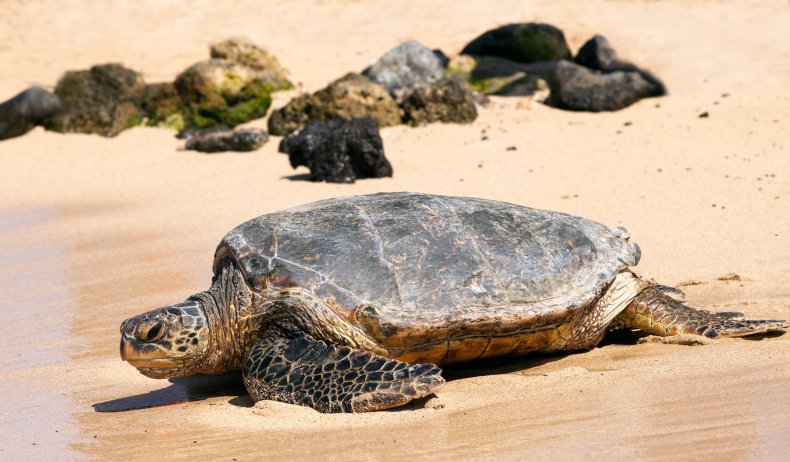A very sick green sea turtle has been found in a clump of seaweed on a beach, while vomiting a strange pink-colored liquid.
The turtle was spotted by resident Jenn Symonds, on Middleton Beach in Adelaide, Australia, who then contacted wildlife volunteers from the local Wildlife Welfare Organisation.
Exhausted and very unwell, the turtle was throwing up the strange pink substance, ABC News Australia reported.
“This enormous green sea turtle was reported to WWO by Jenn from Middleton Beach,” wrote the Wildlife Welfare Organisation (WWO) in a Facebook post containing pictures and videos of the turtle’s rescue.

iStock / Getty Images Plus
Green sea turtles are the largest hard-shelled sea turtles in the world, and only the second largest turtles after the gargantuan leatherback turtle.
They are found in tropical and subtropical waters around the world, having been spotted off the coast of over 140 countries and nesting in around 80 countries, according to National Oceanic and Atmospheric Administration (NOAA).
“These green turtles can weigh around 140kgs [308 lbs] and they are the green colour due to their herbivorous diet,” the WWO wrote.
“This turtle is way out of its range as they are usually found in tropical and sub tropical waters. They are classified as endangered. When special animals like this are reported a strict protocol should be followed.”
The WWO described how, under the direct orders of the Department of Environment and Water, the turtle was to be examined by a veterinarian.
The volunteers first moved the turtle out of the seaweed and onto the sand, before it was taken to a vet for a health assessment so they could figure out what was making it so sick.
“WWO transported the precious cargo to Dr Anne Fowler. She quipped it was the largest animal in her clinic since a 10kg turkey. The WWO team assisted Dr Anne with X-rays and blood tests,” the post said.
Green sea turtles are estimated to have experience a population decline of 50 percent over the past decade.
The major threats to these creatures include being caught in the nets and fishing lines meant to trap other species, habitat loss on beaches due to coastal development, illegal egg harvesting and hunting, being hit by boats and other vessels, and plastic pollution.
Green turtles often eat plastics floating in the ocean thinking it is food, which often includes fishing line, balloons and plastic bags, filling them up so that they cannot eat real food or poisoning them.
They may also become entangled in this plastic pollution, causing them to drown or struggle to stay submerged in ocean currents.
The X-ray scans of the Adelaide turtle found that the turtle had no plastics, hooks or fishing line within its system, however, so something else was causing the turtle to throw up the strange pink liquid.
Further testing will help the vet to determine what is wrong, if the creature can be saved, or if it should be taken to a nearby zoo.
“The blood tests will denote whether there is any anemia or sepsis,” wrote WWO in the Facebook post. If all clear, the turtle will be transported to the zoo tomorrow. It was a long day for the WWO team, Justin, Cheryl, Tess and Jackie but they wouldn’t have missed it for the world. What a privilege.”
Do you have an animal or nature story to share with Newsweek? Do you have a question about green turtles? Let us know via science@newsweek.com.
